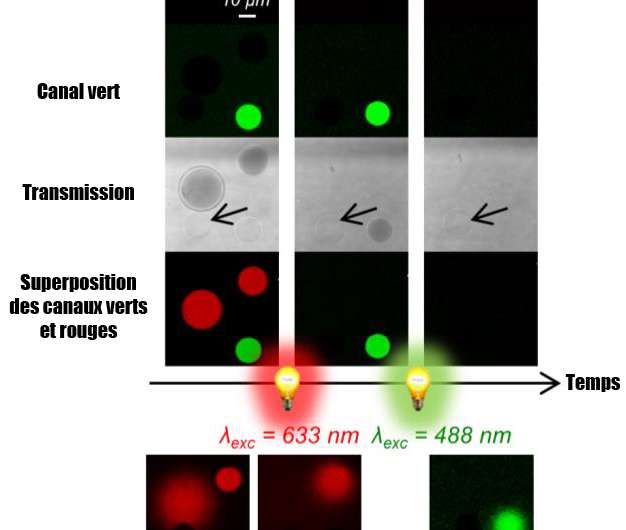Light-induced vesicle explosions to mimic cellular reactions

Cells are the site of a multitude of chemical reactions, the precision of which is envied by scientists. A team of researchers from the CNRS and Bordeaux INP have neared this level of control by controlling the explosion of polymersomes through laser irradiation. These hollow polymer spheres, which can mimic certain cellular functions, react to a specific wavelength and thus release their content on demand. This research has been published in Angewandte Chemie International Edition.
Polymersomes are artificial vesicles that can mimic organelles, compartments naturally found in nucleic cells. Here researchers encapsulated fluorescent molecules in "giant" polymersomes with a diameter of a dozen micrometers. These fluorescent groups have the characteristic of decomposing under the action of light, but only at a specific wavelength. A suitable level of irradiation degrades these molecules and thus increases the solute concentration within the polymersomes. This entails an imbalance, which, because the polymersomes are relatively impermeable, cannot be compensated sufficiently rapidly. The vesicles are thus forced to rupture.
The team designed three types of polymersomes, each containing a specific fluorescent group, meant to react to different wavelengths. The researchers attained such a level of control that they were able to observe the vesicles and target them individually using a confocal microscope equipped with adequate lasers. In addition to light, other methods of control are currently being developed by researchers to rupture microvesicles: temperature, pH, magnetic fields and so on. This research could have medical applications in the long term, but for the time being researchers are studying the possibility of releasing substances in a controlled manner within artificial polymer cells, in order to be able to reproduce and better understand some of the metabolic reactions of the biological cell.
More information: Ariane Peyret et al. Polymersome Popping by Light-Induced Osmotic Shock under Temporal, Spatial, and Spectral Control, Angewandte Chemie (2016). DOI: 10.1002/ange.201609231
Journal information: Angewandte Chemie International Edition , Angewandte Chemie
Provided by CNRS





















